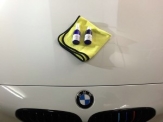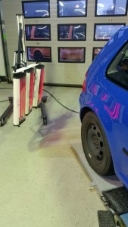|
The application is not like some say “a piece of cake”, but with the right education, right equipment and time it is well doable. Also the surfaces (and surrounding areas) need to be dry. We recommend to use an air compressor to dry out shafts, vents, mirror caps, light units, grill elements etc etc … and use clean and absorbant microfiber towels to be sure the to treat surface and the parts that can influence the to treat surface are dry (so moisture, water, spots etc… don’t have a chance). |
 |
Then the N-XTC Sync. Quartz Coat 4D needs to be applied to a clean microsuede / microfiber applicator to a point that it is pretty full with product (use more then your feeling tells you to do). Spread the coating on the applicator over the surface and apply it after in straight and even lines over the surface. We advise to work part for part (bonnet, panel, door etc…) when applying N-XTC Sync. Quartz Coat 4D.
When done the coating needs to cure 10 minutes in summer and 20 minutes in winter (please use timer) whereafter it needs to be wiped off with a short piled microfiber towel in the same straight and even lines as you applied the N-XTC Sync. Quartz Coat 4D. To make sure the outcome will be as unparalel as possible (do not push too hard with the microfiber towel on the coated area, use a second microfiber towel to wipe off any residue of coating material) Then the curing and bonding starts.
Please preserve against dust and don´t touch the tacky surface for a minimum of 2 hours, now only the top of this 1st layer get’s it’s first hardness. After 24 hours you can apply a 2nd layer in the same straight and even lines as you did the 1st layer. Again we wait 24 hours minimum to let it bond to the 1st top of the layer and also let this 2nd top also get hard.
The N-XTC Sync. Quartz Coat 4D isn’t smooth or slick to feel, which also is a characteristic of the high concentration of ingredients. It also needs to have its roughness to make the layering possible so these can actually build up and create there “thickness” and with that have filling – ability on micro scratches.
To protect from water spots, to smoothen the coated result and to let cure the N-XTC Sync. Quartz Coat 4D for the needed 7 days you need to use the Synt. Coat Finish 3D. This one is really easy to apply. Apply this Synt. Coat Finish 3D to a clean microsuede / microfiber applicator. Spread it over the surface and apply it in thin and even lines over the surface. Immediatly after application you can wipe it off with a clean and short – piled microfiber towel and go in the same even direction as you applied the sealant with the applicator. When waited too long you can spray some of the also silicon resin – maintenance – spray on your microsuede / microfiber towel. This reacts perfect with the sealant and wipes to an unseen highshine you haven’t seen before.
 |
Infrared drying Forced drying with infrared is possible, however this needs to be determined more precisely in every detailing – studio. For the moment we are good with drying the wiped off N-XTC Sync. Quartz Coat 4D 20 minutes with infrared on 60 C and 60 cm distance.. After this the surfaces should cure for 6 – 10 hours which more or less halfs the drying time. Selfspeakingly the second added layer and / or the silicon resin sealant needs to be applied. After 24 hours natural - drying the vehicle can go outside and be part of everyday life. |
1 coat is enough to protect the painted surface for all environmental influences. 2 coats are very good for a superb result in filling – ability on micro scratches, ca 2 microns added layers that provide an extreme unparallel and even shine over the surface. We also attempted and tested with more layers which sometimes can work on filling – ability but on shine and protection (sheeting) we didn’t noticed any mindblowing differences then with the 2 layers. Please note that (depending on) towel and pressure when removing residu you can add up to 1 – 4 micron of thickness to the original paint.
Please notice if you want to increase the thickness of the coating with a multilayer application please note;
- Interlayer adhesion failure
- Peeling or the cracks due to the fact of increasing the thickness of the coating
About use in paintshops
In general this is very well possible like wit hall “glasscoatings”. The surface can be sanded, prepped, cleaned and resprayed.

 +31 (0) 546 456 716
+31 (0) 546 456 716


